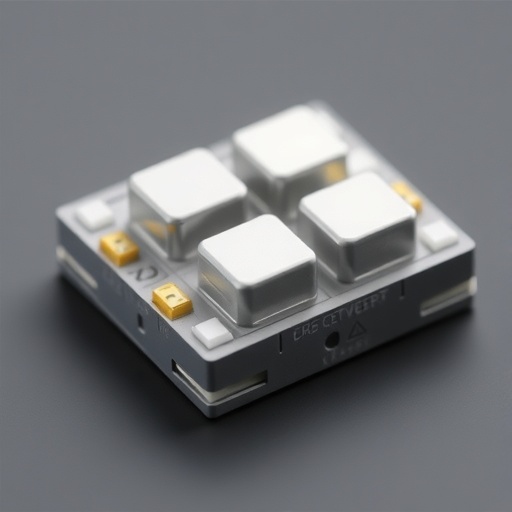In a groundbreaking study published in the journal Ionics, researchers have made significant strides in enhancing the performance of asymmetric supercapacitors through the careful manipulation of sintering temperatures of copper cobalt oxide (CuCo2O4) immobilized on graphitic carbon nitride (g-C3N4). This novel approach not only highlights the potential to optimize the energy storage capabilities of supercapacitors but also sheds light on the underlying mechanisms that govern their efficiency. The research team, comprising Lessa T.S., Babu R.S., and Samyn L.M., explores how varying the sintering temperature can alter the microstructural properties of the material, ultimately impacting the electrochemical performance.
Asymmetric supercapacitors have attracted considerable attention due to their ability to bridge the gap between traditional capacitors and batteries, offering benefits such as faster charge and discharge rates, coupled with higher energy density. By employing a composite of CuCo2O4 and g-C3N4, the researchers aimed to take advantage of the unique properties inherent in both materials. Copper cobalt oxide is known for its high electrochemical activity and stability, while graphitic carbon nitride possesses excellent conductivity and surface area, providing an ideal substrate for metal oxide immobilization.
The innovative aspect of the study revolves around the optimization of the sintering temperature, a critical parameter that influences particle size, morphology, and phase composition of the copper cobalt oxide. By adjusting the sintering conditions, the researchers produced different microstructures that displayed varying degrees of porosity and surface roughness, factors that are crucial in determining the electrochemical performance of the supercapacitors. The team conducted a series of experiments to investigate how these microstructural changes affected the charge storage capabilities and overall device efficiency.
To evaluate the performance of the newly synthesized composites, the researchers employed various electrochemical characterization techniques. Cyclic voltammetry, galvanostatic charge-discharge tests, and electrochemical impedance spectroscopy were utilized to assess the supercapacitor performance under different sintering conditions. The findings indicated that a specific sintering temperature significantly enhanced the electrochemical properties of the CuCo2O4/g-C3N4 composite, leading to improved energy and power densities compared to previously established benchmarks.
The study further delves into the microscopic interactions at play within the composite material. By employing scanning electron microscopy (SEM) and transmission electron microscopy (TEM), the research team observed how the microstructural features influenced ionic transport and electron mobility during charge and discharge cycles. The results highlighted the importance of an optimal sintering process, which maximizes surface area while ensuring sufficient connectivity within the composite structure.
A major breakthrough of this research is the establishment of a correlation between sintering temperature and electrochemical performance metrics. The researchers discovered that increasing the sintering temperature resulted in the formation of highly porous structures, which in turn facilitated enhanced ion diffusion rates. This discovery could pave the way for future research aimed at further optimizing supercapacitor performance through material engineering, directly impacting the design of next-generation energy storage devices.
Additionally, the study touches upon potential applications for the developed CuCo2O4/g-C3N4 supercapacitors in various emerging technologies. As the demand for efficient energy storage systems grows, these asymmetric supercapacitors could be strategically integrated into electric vehicles, renewable energy systems, and portable electronic devices. This versatility reinforces the necessity for ongoing research in this domain, as optimizing materials for specific applications can lead to significant improvements in consumer technology.
Despite the promising results, the researchers acknowledge that more work is needed to fully understand the long-term stability and cycling performance of the alloys in practical applications. Nevertheless, the preliminary findings suggest a paradigm shift in the approach to designing supercapacitors, emphasizing the critical role of material properties and processing parameters in achieving optimal performance levels. Future research may focus on the scalability of this synthesis process, ensuring that production methods can efficiently meet the growing demand for high-performance energy storage solutions.
In conclusion, the study conducted by Lessa and colleagues serves as a pivotal step toward unlocking the full potential of asymmetric supercapacitors. By tuning the sintering temperature of copper cobalt oxide immobilized on graphitic carbon nitride, the researchers have not only enhanced the fundamental understanding of these materials but have also set the stage for future innovations in the realm of energy storage. With ongoing advances in material science and engineering methods, the development of more efficient, durable, and intelligent supercapacitors may not be far off, ultimately playing a crucial role in the transition towards sustainable energy solutions.
This exciting research opens various avenues for exploration and is expected to inspire further studies in the field of supercapacitors and energy storage technology. By leveraging the insights gleaned from this work, scientists and engineers can continue to innovate and contribute to the increasingly urgent challenges surrounding energy consumption and conservation in the modern world.
The implications of this research are extensive, as advancements in supercapacitors will have a cascading effect on many technologies that rely on efficient energy storage systems. As we look ahead, the combination of copper cobalt oxide and graphitic carbon nitride materials may serve as a cornerstone for future innovations that will power everything from portable electronics to large-scale energy grids, ushering in a new era in energy technology.
Subject of Research: Enhancing supercapacitor performance through optimization of sintering temperature of copper cobalt oxide on graphitic carbon nitride.
Article Title: Tuning sintering temperature of copper cobalt oxide immobilized on graphitic carbon nitride for asymmetric supercapacitor performance.
Article References:
Lessa, T.S., Babu, R.S., Samyn, L.M. et al. Tuning sintering temperature of copper cobalt oxide immobilized on graphitic carbon nitride for asymmetric supercapacitor performance. Ionics (2025). https://doi.org/10.1007/s11581-025-06843-8
Image Credits: AI Generated
DOI:
Keywords: Supercapacitors, Copper Cobalt Oxide, Graphitic Carbon Nitride, Sintering Temperature, Energy Storage, Electrochemical Performance.




